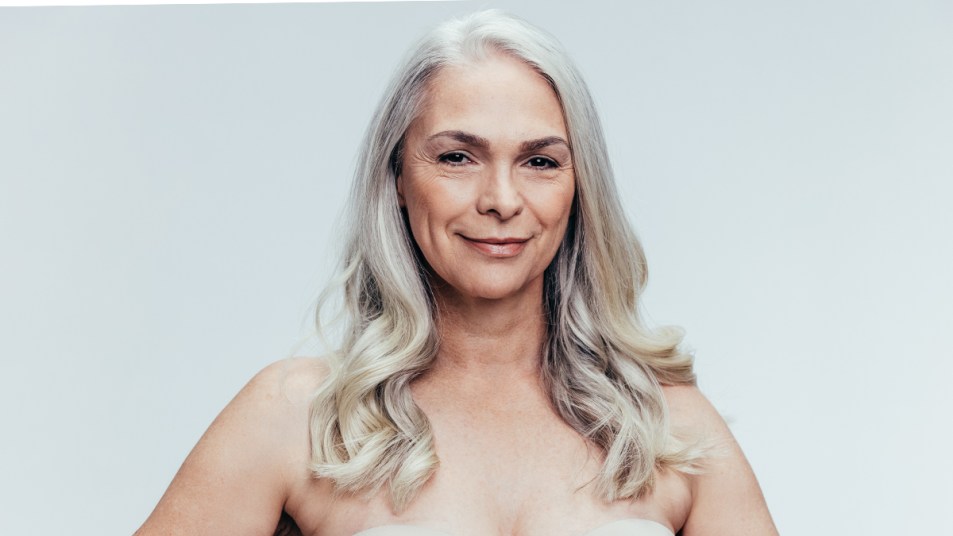Ob/Gyns Share the Surprising Causes — and Cures — for Itchy Breasts
Plus, how hot flashes can play a role!

When your hands, arms or legs get itchy, you chalk it up to dry skin and slather them up with lotion, especially when you don’t see a rash. But what about when the itchiness is on and around your breasts? We talked to top ob/gyns and they told us there are many causes of itchy breasts. And thankfully, it’s usually nothing to worry about — especially if you’re over 50. Read on for the must-know info.
What causes itchy breasts?
“In general, your skin starts to become more dry in the perimenopausal period,” says Kelly Culwell, MD, a board-certified ob/gyn in San Diego and creator of DrLadyDoctor.com, an educational website that focuses on women’s reproductive and sexual health. “The drop in estrogen is the key to a lot of the skin changes that we see, including dry skin, decreased collagen production, decreased elasticity and wrinkles or sagging in the facial area and facial skin,” she explains. “You may also notice increased cellulite, which can come with decreased collagen production.”
And while vaginal dryness is the type of dryness most associated — and dreaded — with aging in women, breasts can be quite susceptible as well. One reason? That estrogen drop causes skin to thin, which can trigger sensitivities to things that may not have bothered you in the past, such as detergents or soaps or certain kinds of fabrics, says Dr. Culwell. For some women, itching is the main result, but for others, dermatitis, or an itchy rash, can develop. What’s more, she adds, “Breasts may become more sensitive and itchy because our bras and our clothing are constantly rubbing against them. So it’s dry skin plus irritation.”
Lastly, dry skin caused by menopause usually pops up in more than one place, she says. So if your breasts are the only part of your body that itches, or the itch is accompanied by a rash, other culprits may be at play.
Related: Look for Products With This Inexpensive Ingredient to Best Treat Psoriasis and Dry Skin
More causes of itchy breasts
Intertrigo
This is a harmless skin condition that appears as a red, bumpy rash in skin folds, where friction causes the irritation and redness. The skin underneath the breasts is a common place to find it, says ob/gyn Laura Corio, MD, author of The Change Before the Change. Washing with a mild bacterial cleanser, then patting the skin dry and dabbing on tea tree oil can help, since the oil’s antiseptic properties help fight bacteria.
Yeast/fungal infection
Although these infections can develop on their own, they can also stem from intertrigo left untreated. That’s because the damage to the skin caused by intertrigo allows the normal fungus present on skin to grow out of control, and the warm and damp conditions in the under-breast skin folds provide the perfect environment. These infections can be more problematic for women with large breasts, says Mary Jane Minkin, MD, a board-certified ob/gyn and clinical professor in the Department of Obstetrics, Gynecology and Reproductive Sciences at the Yale University School of Medicine.
“Also, a lot of ladies in menopause are having hot flashes and this can also lead to a fungal infection,” says Dr. Minkin, due to the sweating that accompanies these episodes. She advises her patients to keep the skin under the breasts as dry as possible (Gold Bond powder is her go-to), and to use a topical antifungal like Lotrimin on the area to clear the yeast. And if these strategies fail, a prescription Lotrisone cream will likely do the trick, she says.
Lichen sclerosus
Although relatively rare, this skin condition can affect the breast area, says Dr. Corio. It begins as white spots that spread into larger itchy patches, but the disorder causes the skin to become very thin and tear easily, especially if it’s scratched. Dr. Corio says it’s best to see your doctor to confirm the diagnosis. If you have lichen sclerosus, your doctor will likely prescribe a corticosteroid cream.
Eczema/psoriasis
If you’re prone to getting eczema or psoriasis, know that the conditions can also crop on the breasts and areolae around the nipples, says Felice Gersh, MD, a board certified integrative gynecologist and founder of the Integrative Medical Group of Irvine, in California. She advises moisturizing the area with unrefined coconut oil, since it contains compounds that reduce inflammation and help strengthen the skin’s natural barrier to improve eczema.
Bug bites
Dr. Minkin says bug bites, especially spider bites, are common on the breasts and can cause a rash and excessive itching. “Spiders are very common in a lot of older homes, and women get bitten in their sleep,” she says. “If the bite is mild you can use a warm water soak, but if it looks nasty and doesn’t want to heal, it may need to be treated with antibiotics.”
Formication
No, we didn’t misspell it. Menopause can actually cause this sensation of bugs crawling on the skin, says Dr. Minkin. The word is taken from the Latin “formica,” which means ant. It’s possible that lower estrogen levels are the culprit, but doctors don’t know for sure what’s behind it, she says. A discussion with your doctor is advised and possible treatments include ice packs, topical hydrocortisone creams and moisturizers to keep the skin hydrated and healthy.
Paget’s disease
This condition brings sores or ulcers around the nipples, and it can lead to cancer, says Dr. Culwell, who adds that although the condition is rare, it’s more likely to affect post-menopausal women, who need to see their doctor if they notice these sores. “It requires treatment to prevent further growth and spreading.”
Inflammatory breast cancer
This rare type of breast cancer makes up just 1% of breast cancers, says Dr. Minkin. “The whole breast is red and itchy and just feels awful,” she says, adding that a visit to your doctor is a must if you have these symptoms.
How to determine the cause of itchy breasts
“Often, itchiness from dry skin will not have a rash, although you might see some scaling,” Dr. Culwell says. “With eczema or psoriasis, you’re usually going to see a rash and the rash often develops around or before the itchiness starts.”
But any itching that develops all of a sudden will require a little detective work, says Dr. Minkin. “Have you used any new detergents or a new brand of toilet paper or a new scented product like a soap or lotion? These are questions you’ll need to ask yourself.” Once you’ve identified a new product or routine that may have triggered your itching, stop doing it and see if the itch clears, she advises. “Instead, use products without dyes or scents. Dove or Neutrogena products are the least annoying on skin.”
Dr. Minkin says antihistamines and topical steroids can also be used, but if they don’t work, see your doctor for a proper diagnosis and other treatment suggestions.
How to treat itchy breasts
“Make sure you keep any fabrics that are touching the breasts very simple. Cotton is usually the best,” Dr. Culwell says. “Avoid synthetic fabrics or lace that can irritating, and be sure your bra fits well.” Menopause, she adds, can also bring changes in breast size, so a bra that’s too tight or too lose can cause more irritation because it will rub more against the skin. She also advises using an unscented, hypoallergenic moisturizer all over the body, including the breasts, after showering. “We put lotion everywhere else, but most of us don’t put it on our breasts.”
For more on breast health, keep reading:
When Your Nipples Make You Cry — MDs Break the Silence on Sad Nipple Syndrome
Are Your Menopausal Nipple Changes Normal? Here’s What an Ob/Gyn Wants You To Know
What Is That Rash Under Your Breast? See What the Experts Say — And How To Get Rid of It
This content is not a substitute for professional medical advice or diagnosis. Always consult your physician before pursuing any treatment plan.













